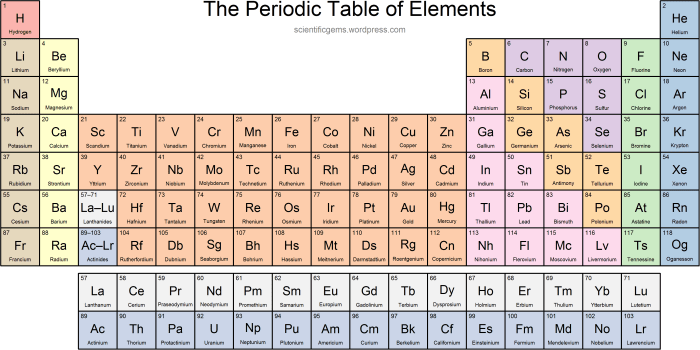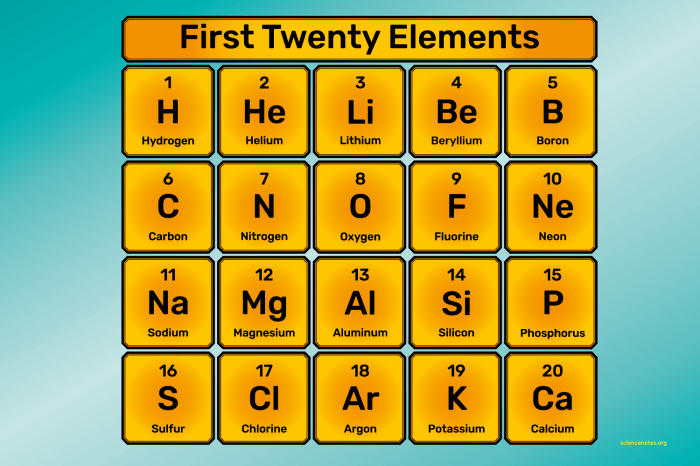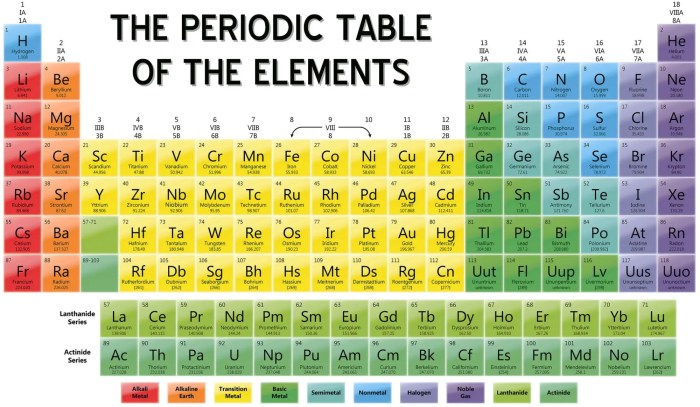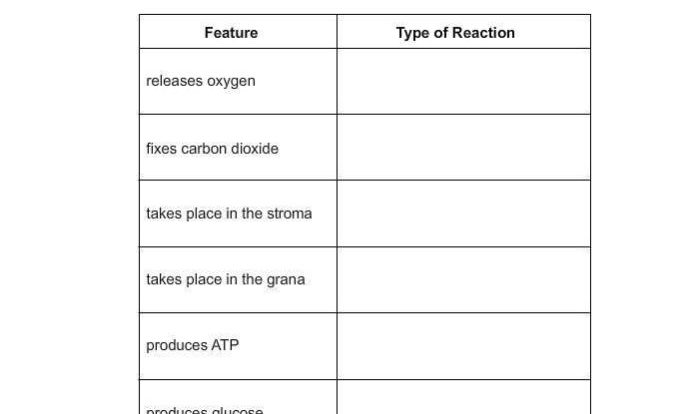Periodic Table Elements 1-20 Worksheet: Embark on a journey through the fascinating world of chemistry as we delve into the properties, reactivity, applications, and historical significance of the first 20 elements of the periodic table. This comprehensive guide will provide a solid foundation for your understanding of the fundamental building blocks of matter.
Through engaging discussions, interactive exercises, and real-world examples, you’ll gain a deep appreciation for the role these elements play in shaping our world. Get ready to explore the periodic table like never before!
Periodic Table Elements 1-20 Overview

The periodic table is a tabular arrangement of chemical elements, organized based on their atomic number, electron configurations, and recurring chemical properties. Elements 1-20 occupy the first two rows of the periodic table and exhibit distinct properties and characteristics.
The periodic table is structured into 18 vertical columns, called groups, and 7 horizontal rows, called periods. Elements in the same group share similar chemical properties, while elements in the same period have the same number of electron shells.
Element Properties and Trends
The following table summarizes the atomic number, symbol, name, and group/period for elements 1-20:
| Atomic Number | Symbol | Name | Group/Period |
|---|---|---|---|
| 1 | H | Hydrogen | 1/1 |
| 2 | He | Helium | 18/1 |
| 3 | Li | Lithium | 1/2 |
| 4 | Be | Beryllium | 2/2 |
| 5 | B | Boron | 13/2 |
| 6 | C | Carbon | 14/2 |
| 7 | N | Nitrogen | 15/2 |
| 8 | O | Oxygen | 16/2 |
| 9 | F | Fluorine | 17/2 |
| 10 | Ne | Neon | 18/2 |
| 11 | Na | Sodium | 1/3 |
| 12 | Mg | Magnesium | 2/3 |
| 13 | Al | Aluminum | 13/3 |
| 14 | Si | Silicon | 14/3 |
| 15 | P | Phosphorus | 15/3 |
| 16 | S | Sulfur | 16/3 |
| 17 | Cl | Chlorine | 17/3 |
| 18 | Ar | Argon | 18/3 |
| 19 | K | Potassium | 1/4 |
| 20 | Ca | Calcium | 2/4 |
Elements 1-20 exhibit periodic trends in their properties, including atomic radius, ionization energy, and electronegativity. Atomic radius generally increases down a group and decreases across a period. Ionization energy, the energy required to remove an electron from an atom, increases across a period and decreases down a group.
Electronegativity, the ability of an atom to attract electrons, increases across a period and decreases down a group.
Reactivity and Chemical Reactions: Periodic Table Elements 1-20 Worksheet

Elements 1-20 exhibit varying degrees of reactivity based on their position in the periodic table. Alkali metals (Group 1) are highly reactive and readily form ionic compounds with non-metals. Alkaline earth metals (Group 2) are less reactive than alkali metals but still form ionic compounds.
Halogens (Group 17) are highly reactive and readily form covalent compounds with metals.
Some examples of chemical reactions involving elements 1-20 include:
- Hydrogen reacts with oxygen to form water (H 2O).
- Sodium reacts with chlorine to form sodium chloride (NaCl).
- Carbon reacts with oxygen to form carbon dioxide (CO 2).
- Nitrogen reacts with hydrogen to form ammonia (NH 3).
Applications and Uses
Elements 1-20 have a wide range of applications and uses in various industries:
- Hydrogen is used as a fuel in rockets and fuel cells.
- Helium is used in balloons, party balloons, and diving tanks.
- Lithium is used in batteries and alloys.
- Beryllium is used in aerospace applications.
- Carbon is used in a variety of forms, including graphite, diamond, and coal.
- Nitrogen is used in fertilizers and explosives.
- Oxygen is essential for life and is used in medical applications.
- Sodium is used in the production of glass, paper, and soap.
- Magnesium is used in alloys and fireworks.
- Aluminum is used in a variety of applications, including construction, transportation, and packaging.
Historical Significance
The discovery and understanding of elements 1-20 played a significant role in the development of chemistry. Hydrogen was discovered by Henry Cavendish in 1766, and oxygen was discovered by Joseph Priestley in 1774. These discoveries laid the foundation for understanding the composition of water and the role of oxygen in combustion.
The periodic table was first proposed by Dmitri Mendeleev in 1869. Mendeleev’s table organized the known elements based on their atomic weights and chemical properties. The periodic table has since been refined and expanded, but Mendeleev’s original concept remains the basis for our understanding of the chemical elements.
Element Fun Facts

- Hydrogen is the most abundant element in the universe.
- Helium is the second lightest element and is used to fill balloons because it is non-flammable.
- Lithium is the lightest metal and is used in batteries.
- Beryllium is a very hard metal and is used in aerospace applications.
- Carbon is the basis of all organic molecules.
- Nitrogen is essential for life and is used in fertilizers.
- Oxygen is essential for life and is used in medical applications.
- Sodium is used in the production of glass, paper, and soap.
- Magnesium is used in alloys and fireworks.
- Aluminum is used in a variety of applications, including construction, transportation, and packaging.
Question & Answer Hub
What is the periodic table?
The periodic table is a tabular arrangement of chemical elements, organized by their atomic number, electron configuration, and recurring chemical properties.
What are the first 20 elements of the periodic table?
The first 20 elements of the periodic table are hydrogen, helium, lithium, beryllium, boron, carbon, nitrogen, oxygen, fluorine, neon, sodium, magnesium, aluminum, silicon, phosphorus, sulfur, chlorine, argon, potassium, and calcium.
What are some important applications of elements 1-20?
Elements 1-20 find applications in various industries, including electronics, medicine, agriculture, and manufacturing. For example, hydrogen is used in fuel cells, helium in balloons and MRI machines, and silicon in computer chips.
